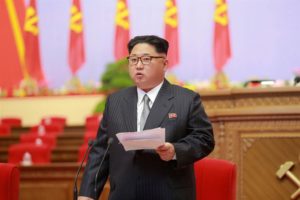
By Sunya Hassan || Contributing Writer
On Sunday, September 3rd, North Korea launched its sixth underground nuclear test and claimed it was a successful trial of their latest hydrogen bomb, leaving many world leaders wondering if the world might be on the brink of nuclear conflict.
The Comprehensive Test Ban Treaty Organization, a group which monitors the Earth for nuclear tests, stated that their monitoring system had “gone off-scale,” when the blast from the test occurred. Seismic stations around the globe picked it up as well. The U.S. Geological Survey recorded it as an earthquake with a magnitude of 6.3, leading scientists to conclude that this was different from North Korea’s last few trials. Their previous test––occurring last year––consisted of an atomic weapon roughly the size of the ones dropped on Nagasaki and Hiroshima towards the end of World War II. But the seismic signatures drawn from those were nowhere near as large as this one.
Atomic bombs use a process called fission, where a chain reaction in which plutonium and/or uranium is split into smaller atoms occur. This releases the massive amounts of energy that killed over 200,000 people in Hiroshima and Nagasaki in 1945. On the other hand, hydrogen (thermonuclear) bombs use a process called fusion. This is when heavy hydrogen isotopes are forced together to release an absurd amount of energy. Modern thermonuclear weaponry packs a punch hundreds of times more powerful than those used towards the end of World War II.
Soon after North Korea confirmed that the tremors were the result of their successful nuclear testing, Trump met with his national security advisors at the White House to examine the facts surrounding the North’s claim. According to Defense Secretary James Mattis, the president wished to be briefed on any and all possible military options available, and Mattis also stated that, “We made clear that we have the ability to defend ourselves and our allies, South Korea and Japan, from any attack and our commitments among the allies are ironclad. Any threat to the United States and its territories, including Guam or our allies, will be met with a massive military response –– a response both effective and overwhelming.” He continued to say, “Kim Jong Un should take heed of the United Nations Security Council’s unified voice. All members unanimously agreed on the threat North Korea poses, and they remain unanimous in their commitment to the denuclearization of the Korean peninsula. Because we are not looking to the total annihilation of a country, namely North Korea, but as I said, we have many options to do so.”
That same day, Trump spoke to the American people regarding the situation through one of his preferred methods of communication: Twitter. “South Korea is finding, as I have told them, that their talk of appeasement with North Korea will not work, they only understand one thing!”
Allegedly, the Trump administration was considering a preemptive strike on the North’s nuclear facilities, but have hesitated due to the cost. Not to mention, North Korea does not need nuclear weapons to attack Seoul, South Korea’s capital, which is not even an hour’s drive away from the border between the two nations. Seoul is home to roughly twenty-five million people, half of South Korea’s overall population. Needless to say, many to most agree that any such attack would undoubtedly begin an all-out nuclear war against North Korea and the casualties could be in the millions.
First-year Sunya Hassan is a contributing writer. Her email is shassan@fandm.edu.